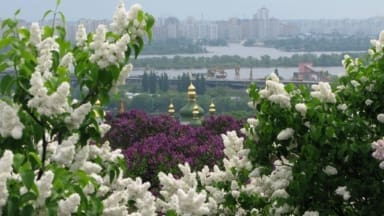
Reporting for the Guardian, Luke Harding writes about the drastic impact of the destruction of Ukraine’s energy infrastructure on the country’s botanical gardens, with their rare and exotic collections. There are eight national botanical gardens in Kyiv, all struggling to keep their collections safe and at the desired temperatures. The largest, Mykola Hryshko National Botanical Garden was founded in 1935 and is one of the largest in Europe. Home to a collection of 13,000 species of trees, flowers and other plants from around the world, the 52 hectare (130 acres) garden is at risk.
Fortuitously the gardens haven’t been directly hit by the fire missiles bombarding the capital, but fallen debris and flying shrapnel have caused damage to the glass and buildings, risking lives and damaging important specimen plants within.
Many have fled the city, but stoic employees remain, working at the gardens as they have for decades. Harding writes of a brave father and daughter team, whom have escaped Mariupol, now working to maintain Mykola Hrysko’s bonsai collection. According to Harding, 1000 volunteers are stoically looking after the plants. “It’s gardening therapy. The volunteers do useful work. They go home feeling better,” explains Roman Ivannikov, Head of Mykola Hryshk’s tropical and subtropical plant department in the article.
With winter approaching and Ukraine’s energy infrastructure destroyed, frequent power cuts and rising energy prices keeping the gardens at temperature is a struggle and their funds have run out. Donations kept the gardens going last year, allowing for the purchase of fuel pellets, alongside volunteers chopping firewood but help will once again be needed for the coming winter. Through social media, the gardens are appealing for help (#heatforgreenhouses) to be able to survive the winter(s). Funds are required for reconstruction, generators and equipment repairs.

